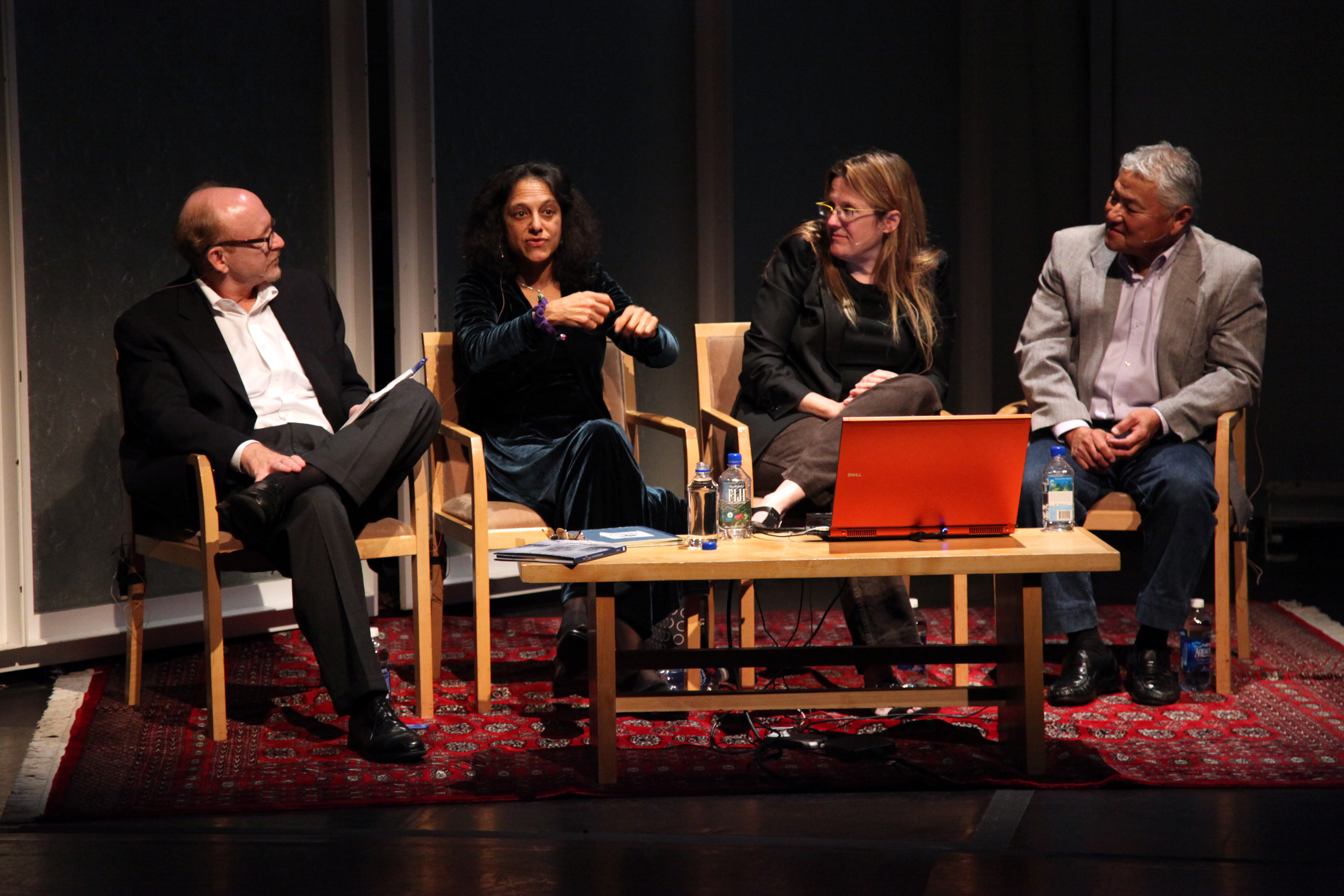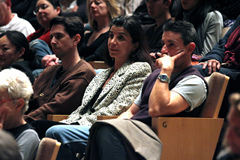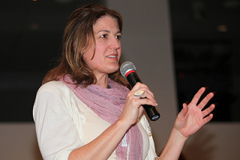
The three participants on a panel called “Why Do We Love Trees” might be expected to have fairly simplistic relationships with the plants in question. But Nalini Nadkarni, Jennifer Steinkamp and David “Mas” Masumoto voiced diverse perspectives, and occasionally complicated feelings.
A canopy scientist, an artist and a farmer, respectively, the trio explored trees from a wide variety of perspectives in their discussion at the Getty Center. Moderator Bob Sipchen, editor-in-chief of Sierra magazine, guided them to think broadly about the subject, which was prompted by Getty exhibit called In Focus: The Tree.
“We love trees, there’s no doubt about that, but it’s a bit of a love-hate relationship,” Sipchen said.
A Human Connection
 Nadkarni, an environmental studies professor at Evergreen State College in Washington, said her love of trees began as a young child. Her parents, a Hindu raised in India and an American Orthodox Jew, imbued her with a strong relationship with the environment.
Nadkarni, an environmental studies professor at Evergreen State College in Washington, said her love of trees began as a young child. Her parents, a Hindu raised in India and an American Orthodox Jew, imbued her with a strong relationship with the environment.
“From my earliest times I sort of had this combination of cultures and ways of approaching the natural world both from science and communications [perspectives], and I found myself wanting to climb trees all the time, which I did.”
Since then, Nadkarni has spent extensive time in trees – she climbs them regularly to this day and leads artists, musicians and others up into the forest canopy.
“There’s a primal sense of ‘I’m in the right sense when I’m up high,’ she said. “There’s something magical about it.”
Steinkamp, a visual artist who has created several works featuring computer-generated trees, has similarly been influenced by different cultures and religious imagery, she said. One of her artworks was inspired by a dervish performance in Istanbul.
“I thought maybe I can make trees that move kind of like dervishes,” she said, showing the piece on a video screen. “These trees are attempting to have a spiritual experience, I guess.”
Another video Steinkamp played showed children trying to hug the video display of trees in a gallery. Nadkarni said the video confirmed that children feel naturally drawn to trees.
A Beautiful Commodity
 Masumoto, who operates an 80-acre organic peach, nectarine and grape farm near Fresno, Calif., said his relationship to trees is different from the others’ because he relies on them for income. He told the audience about the first time he felt a connection to trees, when his father told him what the family peach trees meant for his life.
Masumoto, who operates an 80-acre organic peach, nectarine and grape farm near Fresno, Calif., said his relationship to trees is different from the others’ because he relies on them for income. He told the audience about the first time he felt a connection to trees, when his father told him what the family peach trees meant for his life.
“He joked that the profits from these trees would send us all to college, and it worked,” he said.
Years later, when experts recommended eliminating those same trees because the fruit they produced was not shelf-stable, he initially agreed but changed his mind.
“I had a crazy moment, sort of like the moment in Tiananmen Square, and I stood in front of the bulldozer,” he said. “I realized, ‘what have I done, we are keeping this tree that no one wanted.’”
Now, those trees are a key part of Masumoto’s career, producing unique heirloom peaches that are in high demand.
A Fraught Relationship
Steinkamp was the least effusive of the three panelists about trees – her fellow presenters joked that she’s a tree-hater, and although she disputed that characterization she admitted she is not a giant nature lover.
“I like hotels,” she joked.
But all three agreed that there is a dark side to trees. Nadkarni said she is fascinated by the roots of trees, which people never see and tree-related art rarely features. And though trees often represent beauty in art, it can have less positive connotations.
“The timber that comes from trees makes things like caskets and gallows and all sorts of things that we associate with death,” she said.
There has always been a tension between humans and nature, Sipchen said, and people’s relationship to trees is complicated by the fact that we take their fruit and cut them down to survive.
“Farmers manipulate nature, it’s what we do,” Masumoto said, adding that he considers it humane euthanasia when he has to cut down an old tree.
But Nadkarni pointed out that humans can be good for trees as well: scientists are working to bring the characteristics of old-growth trees to newer forests, which would be good news for the ecosystem.
Trees in Art
 The relationship that many people consciously maintain with trees is seeking shade and appreciating their aesthetic value, Sipchen said. That is reflected through the prevalence of trees in artwork.
The relationship that many people consciously maintain with trees is seeking shade and appreciating their aesthetic value, Sipchen said. That is reflected through the prevalence of trees in artwork.
Steinkamp was first inspired to create artwork of trees when she saw an image of the Greek goddess Medusa. After extensive research, she decided to emulate the movement of the snakes that make up Medusa’s hair through tree branches.
Nadkarni has used physical trees to make art, tying paintbrushes to branches in front of an easel. The product was a painting, but also a sense of the fluidity of trees that resulted from elaborate measurements.
“A single tree, seemingly standing in place, actually moves 186,540 miles per year,” she said. “So if we simply look at it from another perspective, we’re looking at something that’s extremely mobile. Trees have hidden lives, just as we do.”
Masumoto, too, sees an artistic component to his work with trees. Farmers can’t wait around for their trees to produce great fruit, he said; they are constantly tweaking different factors in hopes of creating a better product.
“I do think I work almost as an artist,” he said. “There is so much more beyond economics in farming and working with trees.”
For event photos, please click here.
For full video, please click here.
*Photos by Aaron Salcido




Send A Letter To the Editors